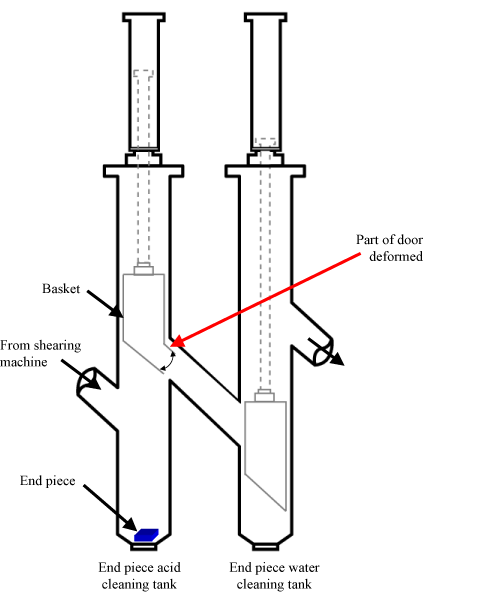Active testing of the Rokkasho Reprocessing Plant stopped for one month from October 1st to October 25th due to damage to equipment in the Head End Building. This is the building where shearing and dissolving of the spent fuel are carried out.
 The damage arose in the end piece cleaning tank. The end pieces are sheared from each end of the spent fuel assemblies before the reprocessing process begins. They are cleaned with nitric acid and stored as radioactive waste. On October 1st, a basket, which contained an end piece and was located within the cleaning tank, stopped operating in response to an alarm. The operator manually jiggled it up and down as usual, but this time it did not resume operating the way it usually did. When the operator checked the inside of the basket again with a camera, the end piece could not be found. Continued checks using a camera showed that the door of the basket was bent. It was not until October 5th that the end piece was finally discovered on the floor of the cleaning tank. By manually forcing the basket up and down the operators had caused the door to become bent. It appears that the end piece became stuck as a result and fell through the gap which had been created.
The damage arose in the end piece cleaning tank. The end pieces are sheared from each end of the spent fuel assemblies before the reprocessing process begins. They are cleaned with nitric acid and stored as radioactive waste. On October 1st, a basket, which contained an end piece and was located within the cleaning tank, stopped operating in response to an alarm. The operator manually jiggled it up and down as usual, but this time it did not resume operating the way it usually did. When the operator checked the inside of the basket again with a camera, the end piece could not be found. Continued checks using a camera showed that the door of the basket was bent. It was not until October 5th that the end piece was finally discovered on the floor of the cleaning tank. By manually forcing the basket up and down the operators had caused the door to become bent. It appears that the end piece became stuck as a result and fell through the gap which had been created.
At first Japan Nuclear Fuel Ltd (JNFL) thought it was a minor problem, but when it realized that the incident required a special report to be submitted to the government JNFL revised its assessment up to the top "A" level. Perhaps due to a lack of experience working in the confines of such a highly radioactive cell, recovering the end piece and replacing the door of the basket turned into a major undertaking. JNFL was forced to call in two people from France from Areva's La Hague reprocessing plant to help out. Active testing finally recommenced on October 25th and shearing of the 110 tons of spent fuel for step 4 was completed on November 8th.
Vitrification begins
Vitrification of highly radioactive liquid waste began on November 5th. The vitrified waste produced at Rokkasho is stored in 40cm diameter by 1.3m long stainless steel canisters. Highly radioactive liquid waste is mixed with molten borosilicate glass and poured into the canisters, where it solidifies as it cools. Each canister holds about 150 liters.
Under an agreement with Aomori Prefecture, the glass canisters will be held at the Rokkasho Reprocessing Plant for 50 years before being shipped to a final repository. However, there are still no candidates to host this repository.
Tritium found in Obuchi Marsh
At a meeting of Aomori Prefecture's environmental radiation assessment committee at the beginning of October, elevated tritium levels were reported for Obuchi Marsh, which borders the Rokkasho Reprocessing Plant on the south side. A level of 2-3 becquerels of tritium per liter of water was discovered. This exceeded the previously recorded range. Rokkasho's liquid wastes are released from a pipe 3 kilometers out to sea. However, Obuchi Marsh is a brackish lake and it appears that the tritium flowed back from the outlet of the pipe. This type of movement of radioactive liquid waste was not considered in the safety assessment for the Rokkasho Reprocessing Plant. It can be expected that this will become a big problem in future.
By Masako Sawai

